Zano drones struggle to achieve lift-off
- Published
- comments
Rory tested the Zano drone ahead of its release
Europe's most successful Kickstarter project is finally ready to deliver the tiny drone that won more than £2.3m in backing last November.
That's the good news. The bad news is that the Zano drone which the company hopes to start sending to backers next week will not at first deliver what was promised last year.
I travelled to Pembroke Dock this week to find out just how challenging it is to deliver on the promises you make in a crowdfunding project.
The Torquing company captured the imagination of the Kickstarter crowd with a promotional video showing the Zano drone following a mountain bike along a trail, hovering above a dinner table to grab a picture and even capturing someone diving from a cliff into the sea.

The first batch of Zanos has belatedly come off the production line
But backers grew increasingly impatient as the promised June shipping date came and went and Torquing provided little information.
Now the firm is trying to engage with its community of supporters, which is perhaps why they invited me to come to the industrial park on which they are based.
I found a small team, headed by Australian technologist Ivan Reedman, testing the first batch of Zanos to come off the production line.
They look impressive and packing so much into so small a space has obviously required a lot of ingenuity.
"We had to get the swarming network, the GPS, and the wireless network all in a smaller footprint than on a mobile phone," Mr Reedman explained.

Ivan Reedman said the tech had to be placed in a smaller footprint than on a mobile phone
But I had been promised the first public demo of the mini-drone and this was where the problems began.
The Zano's appeal is as a device that can follow you outside whatever you are doing and deliver high-quality footage. But, although we tried it in the open air, Ivan explained that outside mode was not yet working so that as soon as it tried to lock on to a GPS signal, it crashed.
Indoors, it functioned slightly better.
Software issues
Torquing's commercial director Reece Crowther launched it from an Android app - still not publicly available - and steered it around a large space, showing off its obstacle avoidance capabilities.
But he could not make it hover on the spot and in less than five minutes he had to land it to change batteries, despite promises of around 15 minutes' flight time. What's more, the short amount of video footage captured by the drone was of quite poor quality.
Nevertheless, the company is determined to start shipping the Zano to backers at the end of this week.
Reece Crowther says all of the issues relate to the software and will be solved by updates delivered to customers over the coming months.
"We thought, 'the hardware's there, the hardware's future proofed - why delay?'," he said.

Backers grew impatient as the drone's shipping date came and went, despite the company having raised £2.3m
What is clear is that the huge success of the Kickstarter appeal has landed this little firm with a similarly sized problem.
"We've had to go from a small research and development company to volume manufacturing," says Mr Reedman. "From expectations of building 800 to 1,000 Zanos to gearing up to building 13, 14 or 15,000."
He also stresses that the nature of Kickstarter, with backers encouraged to get involved in the ongoing project, has led to some of the delays.
There was a demand for a better camera with higher picture quality, and for an onboard micro-SD card slot, which added further complexity and weight to the design.
Pressure
The pressure on Mr Reedman and his small team - only 10 people are involved in the technical side of the project - has obviously been intense.
Only recently has he learned how important it is to communicate one key fact: "One thing we could have done better is remind people that Kickstarter is about backing a project not buying a product. When you back a product there are technical risks."
Nevertheless, there is now a danger that those who have backed Zano - or ordered one after the Kickstarter campaign - will be very disappointed when the mini drone arrives.

A technical team of 10 people has been involved in the project
I spoke to one buyer who did not want to be named. He told me he was very frustrated, and that autonomous flying and the "follow me" feature were what had sold him and others on the drone.
"We've been promised a drone that's different from every other on the market," he said.
"We were expecting autonomy, and right now it looks like we're not getting that."
Mr Reedman insists that his team will eventually deliver what was promised.
Delays
The day after my visit, he sent me pictures of new propellers, which had just arrived and which he said would substantially increase Zano's flying time.
This is by no means the first Kickstarter project to suffer delays.
Even the very successful Pebble Watch shipped four months late after encountering similar problems with volume manufacturing.
But, as I found when I had a go at flying the Zano and then swiftly crashing it into a wall, it is easier these days to generate excitement about a product than it is to land one successfully in the market.
- Published27 August 2015
